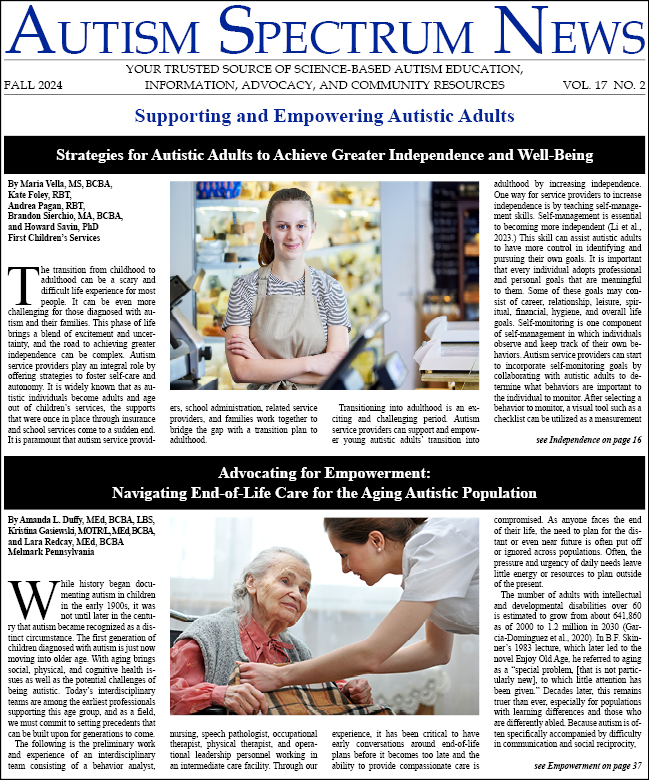According to a 2017 study, “77% of autistic high school students play a very limited role or no role at all in post-secondary planning compared to 47 % of students with intellectual disabilities and 27% of students with all other disabilities” (Gillespie-Lynch, K. et al., 2017). Why do so few autistic students play a role in their own planning?

For many autistic children, school can be a toxic environment. Working on the advice of experts, school staff aim to have autistic children’s behavior conform to neurotypical expectations. The more a child is indistinguishable from mainstream peers, the more successful the school intervention is believed to be.
Disruptive or atypical behavior is labeled oppositional, avoidant, attention-seeking, or inappropriate. Children who don’t cooperate (meaning engage in and respond) to school-led, behavioral interventions are often called non-compliant. The issue is seen to be the child, not the intervention itself. Autistic children are often taught that what they feel, think, or do is wrong and they should do what they are told instead. This can have a life-long impact on self-esteem, self-confidence, and self-advocacy. Quoting a student on a Stanford University panel, “It kills my soul.”
Many interventions treat behavior perceived from the outside, without understanding the meaning or necessity for the child. The behavior is the tip of an iceberg that goes down to sensory, social, emotional, motoric, and cognitive issues the child experiences. A child whose behavior is viewed as problematic may be responding to internal frustration, overstimulation, anxiety, or some other distress. Plans often focus on eliminating the nonconforming or “acting out” behavior instead of trying to understand the experience of the child. We need to support children, not just focus on correcting behavior.
As an example, sometimes autistic children refuse to do work even if they successfully completed a similar assignment before. Autistic children’s productivity can be variable. A majority have sleep disorders, sensory issues and are bullied (Posar & Visconti, 2020, Tomchek et al., 2014; Hoover & Kaufman 2018). If children are tired, hungry, not feeling well, are overstimulated, or stressed, they might not be able to access the skills necessary to work. In a worst-case scenario, this can become a traumatic experience.
This is a slightly altered transcript of an interview with Steph, a British autistic adult recalling life in primary school:
“I would say, ‘I cannot do this. I can’t do it.’ They put a math worksheet in front of me and said, here, do this. It’s like, I can’t do it. They try and make me do it, like, just get it over with.
It’s not that I’m being lazy or objectionable. It’s not that I don’t want to do it. It’s that I… I just didn’t feel able to do it. Them trying to force the issue would then mean that I got more and more upset and annoyed and angry. At that age, around six or seven, I really didn’t express myself well.
I’d just be like, ‘No. Piss off, I can’t do it!’ And then I would get violent. I just struggled and I didn’t feel that they were listening to me. I would start throwing things, flip tables over and then the teachers would drag me to my seat.
I would lash out at them, and they’d physically restrain me. That was the worst time of my life when I was in primary school.
It’s likely that if the teacher had allowed the child to do something else or take a break, none of this trauma would have happened. There can be the same failure of understanding in responding to children with sensory or social overload.”
The story below is excerpted from a story by Lisa Morgan (Lisa Morgan Consulting, LLC), an autism advocate, professional trainer, consultant, and life coach.
An autistic student arrived at class finding the desks rearranged.
“Standing in the doorway, I tune into the sounds of students talking at different speeds, at different decibels, changing topics with a squeal or two thrown in along with an argument here and there. It’s so hard to think. I panic. There are at least 22 desk chairs squeaking on the floor, pencils being sharpened, the teacher giving directions, students finding new seats. I focus on a spot on the floor, completely overwhelmed. I’m rooted by panic from the change, the noise, and the confusion about where to sit. I can’t find words to explain.
The teacher tells me she wants me to move. Will she touch me? I don’t want to be touched. The teacher warns me again to get ready. I need to move. The teacher’s voice is rising. She sounds angry. Is it me? I’m trying so hard. I move towards a desk, heart pounding, a strong perfume smell making it hard to breathe, a student bumps into me and I stop. My panic rises again. I finally find a desk with my name on it. My head hurts from the smells; I’m overstimulated and overwhelmed, so I sit and rock back and forth to calm myself. The teacher walks over and says, ‘See how easy that was? Now sit up straight and stop rocking.’”
These examples are in the classroom, a relatively “safe,” structured, supervised space. The “no man’s land” of the hallway, recess yard, or cafeteria can be even more problematic.
What can be done? This is taken from a viral Facebook post by a teacher named Karen Blacher in October 2020:
“All of my students are neurotypical, but my classroom looks very much like a special education classroom. I teach mindfulness and emotional literacy. I have a calm corner and use it to teach self-regulation. I provide fidgets and sensory toys. My students are thriving. And that made me realize something.
When we treat autistic children the way the world tells us to treat neurotypical children, they suffer. But I have never encountered a child of any age or neurotype who doesn’t thrive when treated like an autistic person should be treated, with open communication, adaptive expectations, and respect for self-advocacy and self-regulation. Maybe neurodiverse people aren’t the only ones who’ve been misunderstood and mistreated all this time. They’re just the ones who feel it most.”
Accommodations necessary for the success of autistic students are covered by the ADA. Why can’t a school have a separate lunchroom for a student of any neurotype who want to eat quietly? People can signal appreciation in other ways than clapping. Autistic students have better achievement in sound-proofed rooms (Bodison et al., 2018). Fluorescent lights are stressful for many and could be replaced.
Research has shown that inclusion improves academic success but not social acceptance. (Morrison et al., 2021) Damion Milton (2012) describes the problem of double empathy. Autistic students have difficulty understanding the perspective of neurotypical students and adults, but neurotypical adults and students are no more proficient at understanding the perspective of autistic students (Crompton et al., 2020). Inclusion of itself doesn’t teach neurotypical students understanding or acceptance of different neurotypes; autistic students are expected to fit in.
There’s much that can be done. It’s possible to create a sensory or adaptive profile predicting problems, to create more effective strategies and to educate neurotypical staff and students to understand and accept different neurotypes. What’s necessary is open-mindedness and a willingness to consider systemic change. What’s most important is to recognize that teaching neurodivergent children the same ways we teach neurotypical children is a recipe for failure, both for the school, and especially for the student.
Marcia Eckerd has worked with autistic individuals as a licensed psychologist for 30 years. She was appointed to the CT ASD Advisory Council and serves on the Clinical Advisory Group of the Asperger’s Autism Network (AANE.org) and is on the Board of Directors of NeuroClastic.org, an autistic nonprofit.
As a prolific writer and lecturer, Marcia has written 3 professional journal articles on autism for the Journal of Health Services Psychology (JHSP), one focusing on diagnosing autistic adults and one specifically on diagnosing autistic women. She has numerous articles in Autism Spectrum News, Autism Parenting Magazine, SmartKidsWithLD.org as well as her blog on Psych Central f(2016- 2020) and her current blog on Psychology Today “Everyday Neurodiversity.” She has presented many workshops on autism, including the “Learning and the Brain” conference co-sponsored by Harvard, MIT, Johns Hopkins, and Tufts, and an international conference, “Special Kids International Summit” co-sponsored by UNESCO.
Marcia graduated from Yale University Magna cum laude and with honors, received her PhD in clinical psychology from the City University of NY in 1982 and completed her internship and fellowship at NY Hospital-Cornell Medical Center (now NY Presbyterian Hospital).
For more information, please visit Dr. Eckerd’s website www.marciaeckerd.com or email eckwestoff@gmail.com.
References
Bodison, S. & Parham, L.D. (2018) Specific sensory techniques and sensory environmental modifications for children and youth with sensory integration difficulties: A systematic review American Journal of Occupational Therapy, 72:(1), 7201190040p1- 7201190040p11
Crompton, C., Ropar, D, Evans-Williams, C., Flynn, E. & Fletcher-Wilson, S. (2020) On the ontological status of autism: the double empathy problem Disability and Society 27 (6) 883-887
Crompton, C., Ropar, D., Evans-Williams, C., Flynn, E. & Fletcher-Watson, S. (2020) Autistic peer-to-peer Information transfer is highly effective Autism, 24(7):1704-1712






One thing here that I would like to point out, is that in your well-intentioned article there are actually no means of how to create certain systemic change. No firm suggestions of how to implement the changes you describe.
I think the issue here lies not in a gap of knowledge of how to better treat neurodivergent children and children in general (the research and testimonials are very clearly available, and often free to the public.) But, that schools are centered around obedience, money, and making children into docile workers because of the factory and capitalist module of learning. It is there to groom them into thinking their life’s purpose is to get a job and make the most money. (Which is, a depressing goal isolated from community, if I am being frank.)
So long as we have a capitalist module of learning, autistic and other disabled students will never be free in an educational setting because schools simply are not built or structured for learning or to accommodate anything outside of a cookie-cutter ideal–otherwise they would implement the various findings from newfound psychology instead of blatantly ignoring or chastizing them in favour of abusing children. (And yes, I do mean abuse, such as restriction of food and bathroom rights. It goes even beyond that in the US specifically if you look at the school-to-prison pipeline.)
So, my point is–I think giving some real thought and expressing it into making a plan and what that plan could look like would be beneficial to your work and goal, and that it simply cannot be done without considering the true function and purpose of schools under our socio-economic systems in place that conjures and support ableist practices and institutions. You cannot solve an intersectional problem without looking at intersectional solutions. It’s quite simple when you look at the big picture that way–though the details to solving such a problem are a fair bit harder.
I hope this helps.
I’m a high functioning Autistic adult myself. I had both positive and negative experiences in the public school system. Elementary school wasn’t so bad despite having the most trouble during kindergarten and first grade. It was a little better in second grade, but by third grade I made sure to be obedient as I could. Part of the reason why this was the case had to do with my traumatic upbringing at home. I was being abused outside of school by various people and this continued well into high school. All four of my high school years were terrible. My mom being increasingly paranoid about people and law enforcement being after her. It got to the point where I didn’t want to be there and now I wished I dropped out my senior year of high school and repeated it at the high school near my dad’s house.
Anything would’ve been better than graduating from a school I never wanted to attend and watching my mom have a mental breakdown. I feel like it was all for nothing. To make matters worse, my mom was the one calling all the shots the last two years despite her paranoia. She had to control everything I did all the while I was being set up for failure. There was never any discussion of placing me in transitional housing once I graduated high school. Instead, I was forced to live like a person without Autism and told that if I stay with a faulty vocational rehab program for people with disabilities, I’d get a good job with or without a college degree. The other issue is how my old guidance counselor was encouraging me to attend college despite the fact that I was getting bad grades. Like many other high functioning Autistic students, all of my needs weren’t being met and I slipped through the cracks as a result.